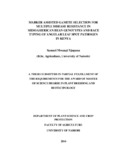| dc.description.abstract | Productivity of common bean (Phaseolus vulgaris L.) is severely constrained by angular leaf spot, anthracnose, bean common mosaic virus and Pythium root rot, among other biotic and abiotic constraints. The most effective and appropriate control measure for these diseases is use of host plant resistance. The objectives of this study were to: i) identify races of angular leaf spot pathogen and their distribution in Kenya, ii) use markers to pyramid genes for resistance to angular leaf spot, anthracnose, root rots and bean common mosaic virus into susceptible commercial cultivars and, iii) conduct early generation selection for combined resistance to angular leaf spot, anthracnose, root rots and bean common mosaic virus and other agronomic traits. A survey was carried out across major bean growing regions of Kenya and 62 samples of angular leaf spot, 55 of anthracnose, 9 of root rots, 121 of common bacterial blight and 32 of bean common mosaic virus diseased materials obtained from the 35 districts visited. From 62 samples collected with angular leaf spot, 57 isolates were obtained and race-typed into 23 physiological races of Pseudocercospora griseola. Races 63-55, 63-63, 63-54 and 63-35 were found to be the most dominant races in areas studied. Two new races, 31-31 and 63-31 were reported for the first time in Kenya. The two main pathogen groups; Andean and Mesoamerican, were also reported. Twelve isolates were classified as from the Andean pathotype group while 45 isolates were from the Mesoamerican pathotype group.
Sixteen populations were generated from crosses among six sources of resistance (MEX 54, G10909, G2333, RWR 719, AND 1062 and BRB 191) and four susceptible popular varieties (KAT B1, KAT B9, GLP 585 and GLP 92). Male gametes with requisite resistance genes were identified using markers SAB-3 for anthracnose, SH-13 for angular leaf spot, SW-13 for bean common mosaic virus, and PYAA-19 for Pythium root rot, and used to construct the F1 with susceptible varieties following gamete selection breeding method. Four varieties susceptible to angular leaf spot, anthracnose, root rots and bean common mosaic virus were utilized as recipient genotypes. The segregating F1 populations and F1.2 families were evaluated for resistance to the four biotic constraints and other agronomic traits in the field at Kabete and Tigoni under natural disease infestation.
Results on molecular marker validation showed that three markers (SAB-3, SH-13 and SW-13) were effective selection tools as they amplified the genes and showed polymorphism among the plants. However, PYAA-19 the marker for root rot had no amplification during PCR reaction and was ineffective in selecting for gene(s) conferring resistance to Pythium root rot. The three markers were used to screen G10909/G2333//AND 1062/BRB 191 for the three disease constraints. Of the 89 male gamete plants that were screened with three markers five were positive for three markers, 18 for two markers, while all others had one or zero markers present. Significant differences (P< 0.05) were detected among the F1 genotypes for angular leaf spot, anthracnose, root rots and bean common mosaic virus. The interaction between genotype and location was also significant (P< 0.05) for all the four disease constraints.
3
The mean yield in Kabete (2256 kg ha-1) was lower compared to the mean yield recorded in Tigoni (3391 kg ha-1). Genotypes derived from population KGS12-16 recorded the highest yield (4762 kg ha-1) while genotypes derived from population KGS12-05 had lowest yield (2490 kg ha-1) among the crosses. Yield was strongly correlated with days to 50 % maturity (r=0.4**) and number of pods per plant (r=0.4**) in all genotypes across the two locations. The results on P. griseola race distribution will assist in developing targeted-resistant varieties for specific bean growing regions of Kenya. This information can also be utilized by bean breeders and pathologists to develop and improve bean varieties with multiple-resistance to the most prevalent and virulent races found in Kenya. | en_US |

